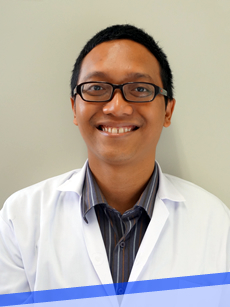
- Ph.D student
- Muhammad Miftahussurur
- 出身大学(Alma Mater)
- Internal Medicine Faculty of Medicine Airlangga university, Surabaya, Indonesia
- 卒業年次(Graduation year)
- 2012
- 出身地(Home country)
- Indonesia
- 専門(Major)
- Gastroenterology
- メッセージ(Message)
- Yamaoka sensei is one of famous H. pylori experts in the world, especially on H. pylori virulence factors field and human migration using H. pylori as a tool. Airlangga university has a research institute called institute of tropical disease (ITD), but we still have limitations on the tools and materials. Indonesia is one of the most varied regions on earth in terms of ethnic, linguistic and genetic diversity. Therefore, it is important to check the prevalence of H. pylori, incidence of gastric cancer and genotyping of H. pylori in various area thorough the countries. Indonesia is categorized as low-risk for gastric cancer (2.8/100,000; GLOBOCAN2012). Although the prevalence of H. pylori infections in Indonesia has been investigated, the reports are controversial and contradictory (0-68%). In addition, no report has examined H. pylori virulence factors in Indonesian strains. Therefore, it remains unclear whether the low incidence of gastric cancer in Indonesia is due to low infection rates or low H. pylori pathogenicity. My first paper in this department confirmed the low incidence rate of gastric cancer in Indonesia may be attributed to the low H. pylori infection rate and low prevalence of precancerous lesions. We also found that the cagA repeat region was isolated from a Javanese patient had high similarity with strain which was isolated in Papua. Interestingly, my second paper confirmed the existence of Maori-tribe type strain in Manado, North Sulawesi. Recently, we collected a lot of samples from five largest islands in Indonesia. We also analyzed virulence factors of Indonesian strains with the next generation sequencing. Moreover we collected blood samples to analyze human SNP. The information of SNP would clarify the history of host human populations and also the association between SNPs and gastric cancer risk in Indonesian peoples. Finally, I am eager to devote my time and energy in order to graduate for my future. The next paper about virulence factors and human migration in Indonesian archipelago will publish soon. I hope everything will run well and smoothly according to our plan.



